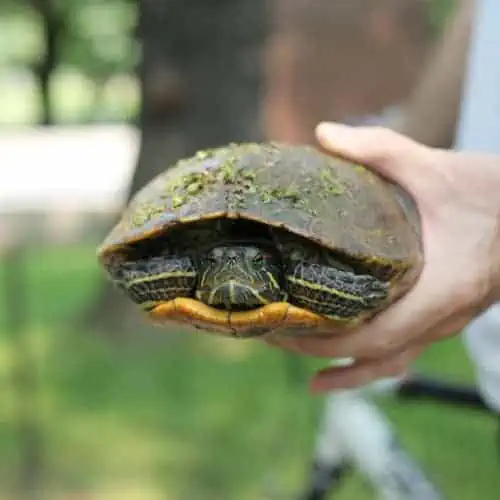
Terrestrial and aquatic turtles may travel from place to place in search of shelter, adequate breeding grounds, and food. As they do so, they may inadvertently enter your property and either pass through it or favor its resources enough to stay. The chances of finding a wild turtle in your backyard are higher in the outskirts of cities or in rural areas located close to wetland systems, but they can easily be relocated with various methods, such as humane turtle traps.
Depending on the features of your backyard, the presence of domesticated animals and young children, the species of the turtle in question, and its odds of carrying pests and harmful pathogens, it may be a bane or a benefit to you. Wild turtles are opportunistic omnivores that, as they travel, may be vectors of disease. Pets and children that approach and touch them can either get hurt by their bite (in the case of snapping turtles) or become contaminated.
While some people wish to attract turtles in order to diversify their wildlife ponds, others may choose to deter them. Like many wild visitors, turtles damage plants, prey on ornamental fish, dig unsightly holes, and leave droppings. In areas where they are naturally plentiful, they may indeed spell trouble. If you’ve been trying to manage an existent turtle problem or intend to prevent their future entry, some of the tips below may help you.
Likelihood of Turtles Entering Your Yard

For wild turtles, not all backyards are made equal. Aquatic species gravitate towards areas with clean bodies of freshwater. These are where they are most likely to find prey, smooth stones for basking under the sun, and even a potential mate. Mature females may wander into your yard looking for ideal nesting sites, and they may leave right after they’ve laid and buried their eggs!
The lack of a fence, the presence of a pond or fountain with moving water features and sounds, and a diverse set of herbaceous, fruit-producing plants increase the likelihood of turtles entering a yard. Although turtles are diurnal, they may slip into your pond, fountain, or pool in the early hours of the morning. These slow movers have a knack for escaping the gaze of any watchful eyes. In just a few days, any fish, tadpoles, and aquatic plants may be gone!
Of course, resident turtles aren’t always bad, especially if they keep to the same area and are a manageable size. There are some specific types, however, that will make you want to contact your local pest control unit.
Troublesome Turtles to Watch Out For

The most troublesome type of freshwater turtle is the snapping turtle. In North America, this type is represented by two large species – the common snapping turtle (Chelydra serpentina) and alligator snapping turtle (Macrochelys temminckii). Found in the central to eastern parts of the continent, they are notorious for packing a powerful bite. The largest of their kind are able to prey on fish, birds, reptiles, amphibians, and small mammals.
Snapping turtles are usually distinguished by their hook-like mouth, large size, shell structure, and aggressive behavior. If you have one in your backyard or ornamental pond, it may have to be removed before it can kill off your fish, damage your plants, or harm curious pets and young children.
Other turtles are seldom as dangerous as snappers. These types tend to introduce harm in a more passive manner. Box turtles, for example, are fond of digging holes that may be tripped on by unsuspecting garden visitors. Their digging behavior can kill young plants and ruin the appearance of a smooth lawn.
In general, all types of wild turtles can be dangerous in areas with waterborne diseases (e.g. salmonella). Small turtles, which can be quite irresistible to young children, may transmit these diseases through mere touch. If you live in an area that is known for having wild turtles, make sure you educate your children and encourage them to observe these animals from a safe distance instead of handling them.
How to Get Rid of Pest Turtles
1) Self-educate on how to properly move a turtle from one place to another

Most people who aren’t familiar with turtles and their dangers may assume that one can simply be picked up and moved from point A to point B. After all, their reputation for being slow animals makes them seem relatively harmless. The truth is that some turtles are able to snap at and bite the source of a threat. Humans attempting to lift and move them may be extremely threatening to them.
Moving a turtle across a road or field doesn’t simply mean pushing its shell forward with a foot or lifting and taking it into your arms. Keep in mind that some species are able to quickly twist their heads and snap their jaws around a toe or finger. If the turtle is to be moved over a short distance, there’s a proper way to lift its shell and place its body onto a moveable surface.
Always wear gloves if you intend to touch the turtle’s shell and do so only if you are accompanied by an expert or have successfully moved turtles before. Avoid approaching a turtle from the front as this may alarm it further. To prevent irreversible injury, do not attempt to move it using its tail. If the turtle is in water, has to be relocated to a distant area, or has made its home in a thickly vegetated part of the garden, you may need to use tools and traps.
2) Use humane animal traps

Baiting and trapping turtles using well-made, escape-proof, and turtle-safe traps may be a more humane means of moving them out of your property. The use of traps should also be safer for you, as it eliminates the need for close contact with the wild turtle. Submerged or surface traps are undoubtedly the most efficient means of removing turtles from water features. These can be made using makeshift components or purchased from specialty stores and commercial fisheries suppliers.
Fully submerged traps, which may come in the form of slat traps, wire basket traps, or funnels, are ideal for snapping turtles. Surface traps, such as tiltboard traps and log traps, are better for sliders and other species that like to bask. These need to be made or ordered with the size of the targeted turtle(s) in mind. Traps that respect the welfare of the animal should not have holes that are large enough to hurt their legs, tail, or head. They should be free of sharp surfaces and flimsily attached parts.
Once the turtle is in a sturdy trap that can support its weight, it can safely be transported to a natural area where it should safely find shelter and prey. You may require the aid of a local biologist or wildlife expert for this part of the process. Note that if you simply place the turtle right outside the bounds of your fence, it may attempt to re-enter your property.
3) Call pest control

If you have no previous experience getting rid of troublesome animals, it may be necessary to consult or hire a legally registered pest control company. If your locality provides services that aid in wildlife rehabilitation, it would be advisable to reach out to the relevant authorities before attempting turtle removal yourself.
Keep in mind that some species of turtles are illegal to trap or move from one area to another as they may be protected by federal or state law. For example, the alligator snapping turtle is a vulnerable species in Florida and is therefore considered quite rare. The state’s fish and wildlife conservation commission should preferably be contacted as they may aid in responsible relocation.
4) Leave them be

If you’ve only just spotted the turtle in your backyard, it may not be necessary to take action. Some wild turtles simply “pass through” private properties in the hopes of reaching another, more suitable location in the wild. They may remain in your backyard for just a day or two, resting and feeding in preparation for the next leg of their journey. Give them time to naturally find their way out with minimal human interference.
Wild turtles may increasingly find their way into developed areas due to the scarcity of suitable habitats. Additionally, anthropogenic developments that have encroached into the wild create obtrusive partitions (resulting in habitat fragmentation) in natural migration pathways. Turtles may have to use animal-friendly backyards to move from one freshwater system to another.
How to Deter Turtles From Entering Your Property

Ensuring that wild turtles are deterred from your property is akin to keeping most terrestrial animals out. It basically means reinforcing your property’s perimeter, making sure that it is tall enough to prevent climbers from creeping in and deep enough to discourage diggers. Of course, natural garden screens, gapped fences, and a weakly constructed boundary are less likely to keep wild turtles out.
Apart from a solid barrier between the great outdoors and your backyard, there are some biology-based means of preventing turtles from becoming permanent residents. A garden that is free of rock piles, leaves, debris, and vegetative coverage is unlikely to be deemed a safe place by a wild turtle. It would thus make sense to remove or cover all potential hiding and nesting places.
Another logical way to deter turtles would be to remove any fallen fruits or vegetables that they may feed on. A backyard automatically becomes a more unappealing place to turtles if it is largely devoid of their favorite food types. You can also make sure that all freshwater features are blocked off or difficult to crawl into. Nonetheless, without a solid and tall fence (with a base that is buried at least 6 inches deep in soil), you can’t truly ensure that wild reptiles will never enter your property.
Should You Get Rid of Turtle Eggs?

A mature female turtle may enter your backyard in search of an adequate nesting spot. Here, she will likely dig, lay her eggs, and do her best to cover them with leaves and soil. Observant gardeners are likely to spot nesting sites due to the disturbed appearance of the substrate. If you do happen to find turtle eggs by displacing some of the topsoil, you may wish to leave them be.
Reproductive rates of wild turtles are already perilously low, so digging out the eggs and getting rid of them would do a true disservice to the mother turtle and her species. Try not to worry too much about hatchlings making a home in your garden as they are likely to venture farther out in search of a new base. For them to do so, however, they will require easily maneuverable exit points.
If you think it dangerous and potentially harmful to leave the eggs in your backyard, try to contact your local wildlife department for help. Note that, although the females tend to leave the nesting site after they’ve successfully laid their eggs, they may wish to return to it year after year. Thus, if no new barriers are put in place, a naturalized backyard may be periodically visited by the same female turtle.


Where do I find phone number for wildlife rehab in my area?
I have probably 60 turtles in my 6 acre one and I suspect they may be eating some of the fish or at least the minnows. And I don’t want them doing that!
Turtles are not the cutest animals people make them out to be. They are eating a lot more fish than you think. They have totally wiped out my pond. You can trap them but if you don’t move them far away they will come back. I’m going to drain my pond and get rid of the turtles for good. I live in a state where shotguns also work